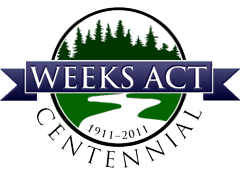The Weeks Act: The Needed Legislation for National Forests in the East
 Bookmark on Delicious
Bookmark on Delicious Digg this post
Digg this post Recommend on Facebook
Recommend on Facebook Share with Stumblers
Share with Stumblers Tumblr it
Tumblr it Tweet about it
Tweet about it Print for later
Print for later
The Weeks Act: The Needed Legislation for National Forests in the East
By: David Govatski- Secretary Weeks Centennial Committee
This article appears in the latest News Quarterly for the New England Society of American Foresters:
A hundred years ago, the White Mountain region was a different sight. Hundreds of photographs and articles depict a region of mountain sides stripped of trees from what was once virgin forest, streams choked with silt from eroding hillsides, and ash from forest fires falling on nearby towns.
Factory owners relying on water power were bemoaning the flooding that occurred after heavy rains and the low flows during summer droughts. Hotel owners were hearing the complaints of the summer tourists who did not like the blackened slopes and streams choked with sawdust and silt. A grow- ing realization between widely diverse interests was building for some- thing to be done in both the White Mountains and the southern Appalachians. With the rising interests and Congressional action taken at the turn of the 20th Century to set aside forest preserves and National Forests from the vast areas of public domain land in the West, the people of the East sought ways to create such Forests. Following several un- successful presentations to Congress, the Society for the Protection of New Hampshire Forests, the Appalachian Mountain Club, and many other New England and eastern organizations took a prominent part in obtaining support of an act introduced by Congressman John W. Weeks of Massachusetts in 1909 which was finally passed by Congress and signed by President Taft on March 1, 1911. This has since been called the Weeks Law and authorized Federal purchase of forest lands at the head of navigable streams.
On March 27, 1911, the White Mountain area was tentatively approved by the National Forest Reservation
Commission at its first regular meeting, pending a favorable report on the geological and hydrological relation between control of forest lands and protection of streams. A favorable report was received as a result of the US Geological Survey during the winter of 1911-1912, in the headwaters of the Pemigewasset River. This report by Forester Benton MacKaye indicated that logging methods and forest fires common at that time were detrimental to the streams and water flow. The Act also provided for cooperation in fire control between federal and state authorities. The fire season of 1910 greatly influenced this legislation because it raised havoc across the western United States, especially in the states of Idaho and Montana, where fires killed 85 people (72 of them firefight ers), and burned more than 3 million acres. The success of the Weeks Law and its contribution to the conservation of natural resources is enormous. Over 40 National Forests were created in the eastern United States. In addition to the nearly 800,000 acre White Mountain National Forest, such forests as the Green Mountain, Pisgah, Allegheny, George Washington, Ottawa and many others were created from these cut over and burned lands. These forests grew out of what was called “The Lands that Nobody Wanted”. Today they are valuable forests providing clean water, wildlife, recreation, forest products and a variety of other goods and services. In 2011 we celebrate the Centennial of the Weeks Act and will take a retrospective look back at what it took to reach broad consensus on such an important issue, what the results were and how we foresee the next hundred years of the Weeks Act will unfold. The role of art, photography, writing and the spoken word will be highlighted in events that will occur in 2011. We hope you will join us.
weekslegacy.org/
- David Govatski on First Annual Stanley Russell Howe Lecture: “Environmental Legacies: Land-Clearing, Forest Use, and Conservation in Northern New England, 1820-1920”
- Randall Bennett on First Annual Stanley Russell Howe Lecture: “Environmental Legacies: Land-Clearing, Forest Use, and Conservation in Northern New England, 1820-1920”
- L Kenerson on 1936 Weeks Act Commemorative WMNF Map
- Raynold Jackson on “The Early Pathmakers"
- Elizabeth Irwin on Welcome to WeeksLegacy.org!

